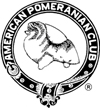Note: This is not the current version of the breed standard.
Appearance.- The Pomeranian in build and appearance should be a compact, short-coupled dog, well-knit in frame. His head and face should be fox-like, with small erect ears that appear sensible to every sound: he should exhibit great intelligence in his expression, docility in his disposition, and activity and buoyancy in his deportment.
Head.- The head should be somewhat foxy in outline, or wedge-shaped, the skull being slightly flat, large in proportion to the muzzle, which should finish rather fine, and be free from lippiness. The teeth should be level, and on no account undershot. The head in its profile may exhibit a little “stop,” which, however, must not be too pronounced, and the hair on the head and face must be smooth or short-coated.
Eyes.- The eyes should be medium in size, rather oblique in shape, not set too wide apart, bright and dark in color, showing great intelligence and docility of temper. In a white dog, black rims around the eyes are preferable.
Ears.- The ears should be small, not set too far apart nor too low down, and carried perfectly erect, like those of a fox, and like the head, should be covered with soft, short hair.
Nose.- Should be self-colored in Browns and Blue. In all other colors, should be black.
Neck and Shoulders.- The neck, if anything, should be rather short, well set in, and lion-like, covered with a profuse mane and frill of long straight hair, sweeping from the under jaw and covering the whole of the front part of the shoulders and chest as well as the top part of the shoulders. The shoulders must be tolerably clean and well laid back.
Body.- The back must be short, and the body compact, being well ribbed up and the barrel well rounded. The chest must be fairly deep and not too wide.
Legs.- The forelegs must be well feathered and perfectly straight, of medium length, and not such as would be termed “leggy” or “low on legs,” but in length and strength in due proportion to a well-balanced frame. The hind legs and thighs must be well feathered down to the hocks, and must be neither cow-hocked nor wide behind. They must be fine in bone and free in action. The feet should be small and compact in shape.
Tail.- The tail is a characteristic of the breed, and should be turned over the back and carried flat, being profusely covered with long spreading hair.
Coat.- Properly speaking there should be two coats, an under and an over coat; the one a soft fluffy undercoat, and the other a long, perfectly straight and glistening coat covering the whole of the body, being very abundant around the neck and forepart of the shoulders and chest, where it should form a frill of profuse, standing-off, straight hair, extending over the shoulders as previously described. The hind quarters like those of the collie, should be similarly clad with long hair or feathering from the top of the rump to the hocks. The hair on the tail must be, as previously described, profuse and spreading over the back.
Color.- The following colors are admissible: Black, brown, chocolate, red, orange, cream, orange-sable, wolf-sable, beaver, blue, white and parti-colors. The blacks, blues, browns and sables must be free from any white, and the whites must be free from lemon or any other color. A few white hairs in any of the self-colors shall not absolutely disqualify but should carry great weight against a dog. In parti-colored dogs, the colors should be evenly distributed on the body in patches. A dog with a white foot or a white chest would not be a parti-colored dog. Whole colored dogs with a white foot or feet, leg or legs, are decidedly objectionable and should be discouraged and cannot compete as whole colored specimens. In mixed classes where whole colored and parti-colored Pomeranians compete together, the preference should-if in other points they are equals-be given to the whole colored specimens. Sables must be shaded throughout with three or more colors, as uniformly as possible, with no patches of self-color. Oranges must be self-colored throughout and light shadings though not disqualifying should be discouraged.
Points
Appearance—————————————————-10
Head————————————————————5
Eyes————————————————————-5
Ears————————————————————-5
Nose————————————————————5
Neck and shoulders——————————————–5
Body————————————————————10
Legs————————————————————10
Tail————————————————————-10
Coat————————————————————25
Color———————————————————–10
Total——————————————————-100
N.B.- Where classification by weight is made, the following scale, passed by the club as the most suitable division, should be adopted by show committees:
1. Not exceeding 7 pounds.
2. Exceeding 7 pounds.
Where classification by color is made, the following division should be adopted:
1. Black.
2. Brown or chocolate.
3. Red, orange or cream.
4. Sables.
5. Any color not mentioned above.

